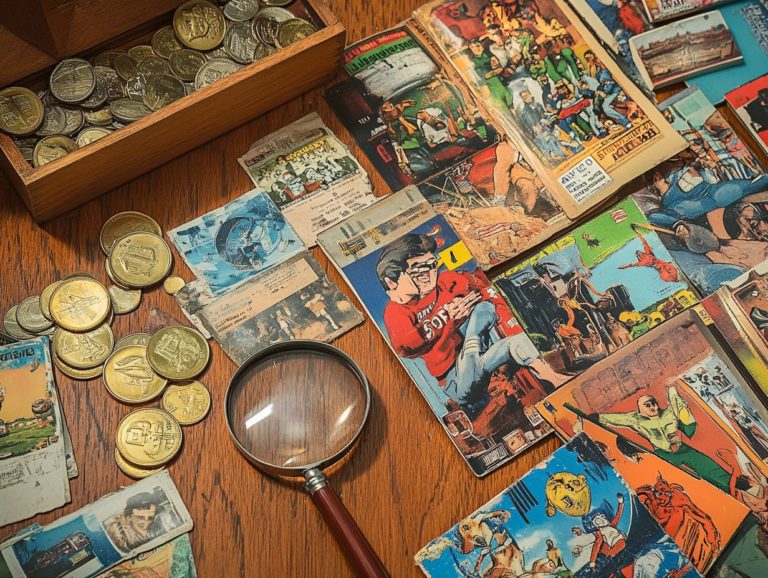How to Spot Fake Collectibles?
The world of collectibles is a thrilling yet treacherous landscape. Don t let a counterfeit ruin your collection! The siren call of rare items often conceals the lurking threat of counterfeits. From vintage toys to exquisite art pieces, even seasoned collectors can find themselves misled by expertly crafted fakes.
This article delves into the various types of counterfeit collectibles. It illuminates their distinct characteristics and teaches you how to identify them before committing to a purchase.
With expert insights and practical advice at your fingertips, you ll discover crucial warning signs and prevention strategies that will shield your investments from costly blunders.
Are you prepared to elevate your collecting game? Let s dive in and arm yourself with the knowledge to protect your collection!
Contents
- Key Takeaways:
- Common Types of Fake Collectibles
- How to Identify Fake Collectibles
- Consequences of Buying Fake Collectibles
- Introduction
- Preventing the Purchase of Fake Collectibles
- Frequently Asked Questions
- What are some general tips to spot fake collectibles?
- What are some specific signs to look for when trying to spot fake collectibles?
- How important is it to do research before purchasing a collectible?
- What are some red flags that suggest a collectible may be fake?
- Are online purchases of collectibles more prone to being fake?
- What should I do if I suspect a collectible I own may be fake?
Key Takeaways:

- Fake collectibles can misrepresent any item, from art to sports memorabilia.
- Common fakes include reproductions, counterfeits, and forgeries. Watch for poor quality and suspicious details.
- Look for warning signs: unrealistically low prices and absence of authentication.
What are Fake Collectibles?
Fake collectibles are items that are intentionally misrepresented to seem authentic. They trick buyers in the collectibles market. This includes everything from counterfeit trading cards to unlicensed Funko Pops and replicas of vintage memorabilia that lack genuine serial numbers and proper packaging.
As the demand for collectible toys and trading cards rises, so does the risk of scams targeting unsuspecting collectors. It s essential to understand what constitutes a fake collectible to maintain item authenticity and ensure your satisfaction as a collector.
The motivations behind creating these counterfeit items often hinge on enticing profit margins, driven by the rarity and desirability of genuine collectibles. Common targets for these counterfeits include:
- Rare coins
- Sports memorabilia
- Vintage toys
Forgers can mimic originals using deceptive techniques like altered stamps or forged signatures. These practices mislead collectors looking to invest in authentic pieces and erode trust in the collectibles market as a whole.
Purchasing fake collectibles can lead to serious financial repercussions. This underscores the importance of vigilance and education in identifying potential fraud.
Common Types of Fake Collectibles
The collectibles market is teeming with a variety of counterfeit items. This includes everything from imitation trading cards to unlicensed collectible toys featuring your favorite characters. The issue encompasses fake Funko Pops and Pok mon cards, as well as a range of memorabilia that simply lacks authenticity.
These fakes often have packaging imperfections or low-quality images that fall short of the standard set by genuine products. By familiarizing yourself with common types of counterfeits, you can navigate the market with confidence and steer clear of scams that could jeopardize both your collection and financial investments.
Examples and Characteristics
Counterfeit trading cards often showcase subpar printing quality. This glaring sign of neglect can seriously diminish their historical value and rarity, making them quite easy to identify.
For example, you might notice misaligned character details or a texture that feels off. This should nudge you to scrutinize the authenticity of the card. Genuine collectible cards usually boast distinctive packaging, adorned with unique artistry that sets them apart from the generic versions churned out by unscrupulous sources.
When examining the ink coloration, be wary if it seems washed out or excessively vibrant compared to authentic cards; this can be another red flag. Pay close attention to the specific card stock as well true collectibles usually have a particular feel and weight that counterfeits can’t quite mimic.
Features like holographic images or foiling deserve a keen eye, too. Counterfeiters often resort to low-quality materials, leading to noticeable differences in shine or texture. Additionally, keep an eye out for inconsistencies in serial numbers or the absence of tamper-proof seals, as these can be crucial indicators of a fake.
By being vigilant, you can safeguard your investments from the pervasive counterfeit market.
How to Identify Fake Collectibles

Identifying fake collectibles demands a keen eye and a solid grasp of spotting discrepancies in authenticity. Familiarizing yourself with advanced technologies, like UV authentication and AlpVision technology a method used to verify authenticity can help you spot fakes.
Look out for signs of counterfeiting. Watch for inconsistencies in packaging, low-quality images, and the unsettling absence of serial numbers.
By employing robust anti-fraud strategies and conducting thorough research, you must educate yourself to avoid costly mistakes!
Key Warning Signs
As you assess collectibles, stay vigilant for key warning signs that might indicate counterfeit items. Look closely for packaging flaws and low-quality images; these often serve as red flags.
Real collectibles have clear, high-quality packaging, distinct serial numbers, and holograms that confirm their legitimacy. When these features are missing or poorly executed, it s time to question the item’s authenticity.
Pay attention to the seller’s reputation. A lack of feedback or vague descriptions can be telltale signs of deceptive practices. If the price seems too good to be true, especially for high-demand items, it might signal an attempt to sell you a fake.
Delving into the materials used can also provide valuable insights. Genuine collectibles often use premium materials that are likely absent in counterfeits. By educating yourself on the common characteristics of authentic items and maintaining skepticism, you can enhance your decision-making process.
In summary, staying observant and informed is crucial for safeguarding your collection.
Expert Tips and Techniques
Expert tips for spotting fake collectibles involve effective fraud detection techniques that can elevate your collectible card games and toys’ investment potential. For more insights, check out how to spot a good collectible investment by concentrating on assessing character details and understanding the context of achievements to gauge the resale value of your items.
Connecting with fellow enthusiasts can greatly enhance your knowledge. Engaging in discussions within dedicated online forums or local clubs fosters a community where insights and experiences are freely shared.
This collective wisdom proves invaluable when deciphering intricate details such as material quality, printing techniques, and signature verification that are crucial for distinguishing genuine items from replicas.
Utilizing resources like provenance records and third-party grading services can further validate authenticity, providing a safety net as you navigate high-stakes transactions. Tapping into this community knowledge helps you acquire authentic treasures while preserving your collection’s integrity.
Ultimately, building connections and seeking expertise will empower you as a collector.
Consequences of Buying Fake Collectibles
The consequences of purchasing counterfeit collectibles can be severe, resulting in financial losses and potential legal complications that threaten your reputation and investment potential.
Investing in fake items can seriously hurt your wallet! You jeopardize the value of your collection and face challenges with customer satisfaction and possible disputes over authenticity claims.
The repercussions extend beyond your personal experience, undermining trust within the collectible marketplace. In conclusion, remaining vigilant and well-informed is essential for ensuring the value of your investments.
Introduction
Understanding the risks of purchasing counterfeit collectibles is essential for collectors. Not only can it lead to financial losses, but it might also result in legal issues. Let s explore these challenges and how to avoid them.
Financial Losses and Legal Issues

Financial losses from buying counterfeit collectibles can be significant. When you unknowingly invest in scams, both the resale value and your overall satisfaction can suffer.
Imagine paying inflated prices for what you believe is a genuine item, only to feel disappointed upon discovering its true nature. Legal issues may arise as you seek restitution or attempt to prove authenticity, complicating your collecting journey and impacting future transactions.
In recent years, the marketplace for collectibles has seen a troubling increase in counterfeit items. Estimates suggest that up to 10% of high-value collectibles could be affected. Act now! This troubling trend shatters trust among collectors and creates a substantial financial burden.
Consider this: if you mistakenly purchase a counterfeit signed sports jersey for $1,500, your loss could extend well beyond that initial price when you factor in legal recovery costs and potential appraisal fees.
Navigating the complicated web of legal claims can be daunting. Lengthy disputes with sellers over authenticity may lead to additional monetary setbacks and emotional stress.
Preventing the Purchase of Fake Collectibles
Preventing the purchase of fake collectibles requires diligent research and effective verification methods. These practices enable you to make informed choices about your investments.
As a buyer, familiarize yourself with anti-fraud strategies and scrutinize seller information to identify reputable sources.
By using online forums and expert reviews, you can significantly enhance your ability to recognize genuine items while avoiding potential scams and counterfeit pitfalls.
Research and Verification Methods
Effective research and verification methods are crucial for ensuring item authenticity, especially when purchasing collectibles online or at auction houses.
Utilize resources like databases, expert forums, and verification services to confirm the legitimacy of items and their sellers.
Implementing thorough research practices boosts your confidence in transactions and minimizes the risk of acquiring counterfeit collectibles.
Start by accessing renowned databases that specialize in tracking the history of ownership for various items, such as art, antiques, and memorabilia.
Building relationships within collector communities provides invaluable insights and recommendations, revealing firsthand experiences with specific sellers or items.
Engaging with appraisers or attending relevant workshops equips you with the skills and knowledge for accurate assessment.
Forums dedicated to specific niches often host discussions about trends, warnings about forgeries, and success stories that serve as valuable lessons for both novice and seasoned collectors.
Frequently Asked Questions
What are some general tips to spot fake collectibles?

Some general tips include studying the item’s packaging, examining its quality and materials, and comparing it to authentic examples. Research the seller and be cautious of unusually low prices.
What are some specific signs to look for when trying to spot fake collectibles?
Look for misspellings or incorrect logos on the packaging, poor quality or unusual colors, and missing or incorrect serial numbers. Be cautious with items claimed to be “rare” or “limited edition” without proper documentation.
How important is it to do research before purchasing a collectible?
Doing research is crucial before purchasing collectibles. Educate yourself about the item, its history, and its market value to avoid falling victim to fake collectibles.
Have you encountered any counterfeit items? Share your experiences and tips below to help others in the community!
What are some red flags that suggest a collectible may be fake?
Watch out for pressure to make a quick purchase. If you can’t view the item in person or if the seller lacks proof of authenticity, these are major warning signs.
Be especially cautious if the seller has a history of selling fakes.
Are online purchases of collectibles more prone to being fake?
Buying collectibles online can be riskier. It’s tough to examine items without seeing them firsthand.
However, reputable online marketplaces often have processes to verify items and provide detailed photos and descriptions.
What should I do if I suspect a collectible I own may be fake?
If you think your collectible might be fake, consult a trusted appraiser or expert. They can provide a thorough evaluation.
If it’s confirmed as fake, consider reporting the seller or exploring legal options.






